Have you started backing off on your air conditioning? Maybe you’ve even pulled out a jacket to wear at night. That means it’s fall, and winter is not far behind. Prep your home for colder weather with these energy saving tips that keep you comfortable without increasing your energy bill.
Use Natural Light
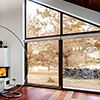 Use the sun’s heat to warm your home on sunny days by opening the window coverings of your south- and west-facing windows. You can warm rooms significantly with natural light even when the days are shorter, and you’ll get the maximum benefit of this tip if you keep your windows clean. Just be sure to close the blinds after sunset to keep drafts away.
Use the sun’s heat to warm your home on sunny days by opening the window coverings of your south- and west-facing windows. You can warm rooms significantly with natural light even when the days are shorter, and you’ll get the maximum benefit of this tip if you keep your windows clean. Just be sure to close the blinds after sunset to keep drafts away.
Reverse Ceiling Fans
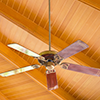 Most of us will turn back the clock for the winter months, which is also a reminder to change your smoke alarm batteries. While you have the step stool out, change the direction of your ceiling fans, too. In colder months, ceiling fans should rotate clockwise. You know that hot air rises. By reversing the fan’s direction, you draw colder floor air to the ceiling, mixing it with warmer air and sending it back down your walls. This trick allows you to turn down the thermostat a bit to give your heating unit a break, but keep fans on the lowest setting or too much moving air can chill you instead.
Most of us will turn back the clock for the winter months, which is also a reminder to change your smoke alarm batteries. While you have the step stool out, change the direction of your ceiling fans, too. In colder months, ceiling fans should rotate clockwise. You know that hot air rises. By reversing the fan’s direction, you draw colder floor air to the ceiling, mixing it with warmer air and sending it back down your walls. This trick allows you to turn down the thermostat a bit to give your heating unit a break, but keep fans on the lowest setting or too much moving air can chill you instead.
Service Your System
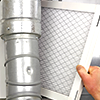 Waiting to service your heating system after your unit breaks down is no fun. Think ahead and have your furnace or boiler professionally cleaned now. You’ll benefit from a thorough safety check as well. At the least, save energy by replacing your furnace filter every month as dirty filters force your unit to work harder. While doing fall cleanup outside, use a broom to dust off leaves and grass clippings around your HVAC equipment to help it run more efficiently.
Waiting to service your heating system after your unit breaks down is no fun. Think ahead and have your furnace or boiler professionally cleaned now. You’ll benefit from a thorough safety check as well. At the least, save energy by replacing your furnace filter every month as dirty filters force your unit to work harder. While doing fall cleanup outside, use a broom to dust off leaves and grass clippings around your HVAC equipment to help it run more efficiently.
Prep the Fireplace
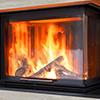 If you have a fireplace that isn’t used, seal it off to keep heat from escaping. For working fireplaces, keep the damper closed when the fire is out to avoid warm air going out the chimney. To push heat away from the chimney, the Department of Energy suggests opening the bottom dampers in the firebox or open a nearby window an inch and close the door to the room. When you throw a log on and snuggle up, don’t forget to lower the thermostat to 55°F.
If you have a fireplace that isn’t used, seal it off to keep heat from escaping. For working fireplaces, keep the damper closed when the fire is out to avoid warm air going out the chimney. To push heat away from the chimney, the Department of Energy suggests opening the bottom dampers in the firebox or open a nearby window an inch and close the door to the room. When you throw a log on and snuggle up, don’t forget to lower the thermostat to 55°F.
Program Your Thermostat
 An electronic programmable thermostat saves energy by allowing you to change the temperature of your home throughout the day. These thermostats can store multiple daily settings and allow you to override them when needed. You can get up to 10 percent savings on heating costs by setting the thermostat 10-15 degrees lower while you are away or sleeping. Program the thermostat to heat up your home 30 minutes before you arrive or wake and you won’t sacrifice your comfort.
An electronic programmable thermostat saves energy by allowing you to change the temperature of your home throughout the day. These thermostats can store multiple daily settings and allow you to override them when needed. You can get up to 10 percent savings on heating costs by setting the thermostat 10-15 degrees lower while you are away or sleeping. Program the thermostat to heat up your home 30 minutes before you arrive or wake and you won’t sacrifice your comfort.
The crispness in the air that you’ve noticed is a sure sign the fun of fall and winter is on its way. By taking a few energy saving steps now, you’ll be set to keep your heating bill down and keep up the cozy in your home.


 Heat flows from warm to cold spaces. In the winter, for instance, heat moves from your living space to unheated areas like your attic, garage, or basement before escaping to the outdoors. This loss of heat is backfilled by your heating system working overtime. The same is true for the warmer months, when hot air flows into your house. Because it’s cooler it causes your air conditioner to run steadily. By insulating your ceilings, walls, attic space and floors, you create a resistance to this natural heat transfer and decrease the strain on your heating and cooling systems.
Heat flows from warm to cold spaces. In the winter, for instance, heat moves from your living space to unheated areas like your attic, garage, or basement before escaping to the outdoors. This loss of heat is backfilled by your heating system working overtime. The same is true for the warmer months, when hot air flows into your house. Because it’s cooler it causes your air conditioner to run steadily. By insulating your ceilings, walls, attic space and floors, you create a resistance to this natural heat transfer and decrease the strain on your heating and cooling systems.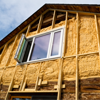 The effectiveness of insulation is measured by what’s called the R-value, or its ability to resist heat transfer (R for resistance). The higher the R-value, the better. Unfortunately, many homes don’t meet the minimum R-value standard for energy efficiency set by the
The effectiveness of insulation is measured by what’s called the R-value, or its ability to resist heat transfer (R for resistance). The higher the R-value, the better. Unfortunately, many homes don’t meet the minimum R-value standard for energy efficiency set by the  Space: Unfinished walls, floors and ceilings
Space: Unfinished walls, floors and ceilings Space: Unfinished attic floor, odd-shaped wall cavities, or around obstructions such as pipes and wires
Space: Unfinished attic floor, odd-shaped wall cavities, or around obstructions such as pipes and wires Space: Exterior walls, basement or crawl spaces
Space: Exterior walls, basement or crawl spaces